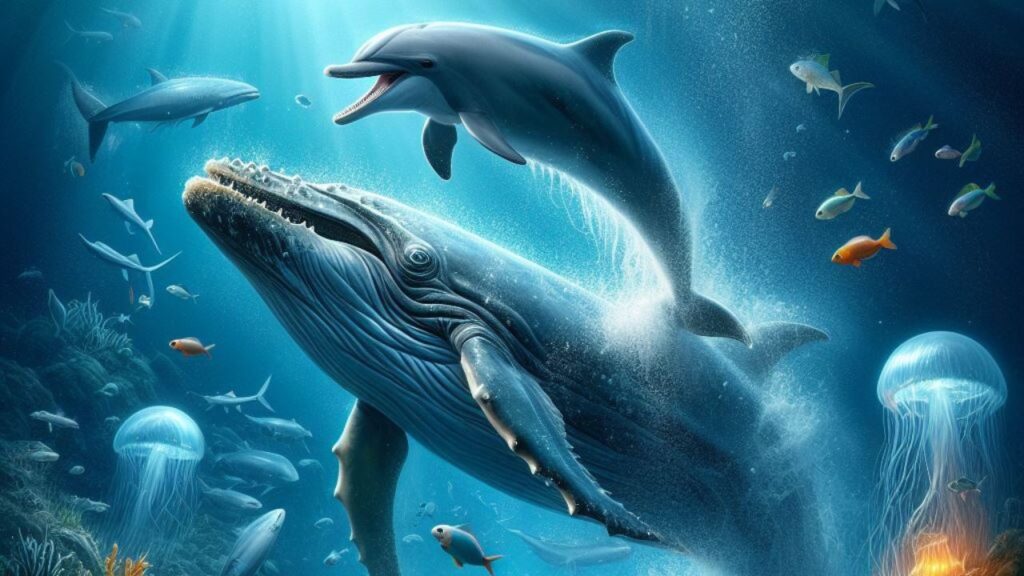Last updated on July 1st, 2024 at 12:15 pm

Are you intrigued by the captivating interactions between dolphins and humpback whales in the vast expanse of the ocean?
Despite belonging to different families, these two marine mammals often engage in fascinating encounters that have piqued the interest of researchers and enthusiasts alike.
Let’s explore further into the dynamics of this unique relationship and uncover the wonders it holds.
Do Dolphins Attack Humpback? No, dolphins do not typically attack humpback whales. Instead, they may interact peacefully or cooperatively with them, sometimes even forming mixed-species groups.
Table of Contents
The Peaceful Coexistence
Contrary to popular belief, dolphins do not typically attack humpback whales. In fact, observations from researchers and marine enthusiasts have revealed instances of peaceful coexistence and even cooperation between these two species.
Humpback whales are known for their gentle nature, and they often tolerate the presence of dolphins in their vicinity without aggression.
See Also: Humpback Whale Vs Orca: Ocean Giants Showdown

Behavioral Observations
An extensive range of behavioral behaviors has been painstakingly documented by researchers studying the interactions between humpback whales and dolphins.
Of these observations, a recurrent pattern is the dolphins’ propensity to swim in close proximity to humpback whales, sometimes positioning themselves to ride the bow wave produced by the larger whale.
This conduct raises the possibility that dolphins view humpback whales as friends or even protectors. These discoveries provide important new information on the intricate social dynamics that are present in maritime environments.
| Behavior | Description |
| Swimming near humpback whales | Dolphins often swim in close proximity to humpback whales, indicating a level of comfort and familiarity with their presence. |
| Riding bow waves | Dolphins may position themselves to ride the bow wave created by humpback whales, potentially for playful or social reasons. |
| Perceived companionship | The behavior of swimming near humpback whales suggests that dolphins may perceive them as companions or sources of protection. |
Cooperative Foraging
Their ability to forage together is one of the most fascinating aspects of the relationship between humpback whales and dolphins. [Do Dolphins Attack Humpback?]
Research has shown that in some areas, like the waters off the coast of Western Australia, humpback whales and dolphins can work together to hunt prey.
This cooperative endeavor proceeds smoothly, as dolphins use their dexterity and echolocation skills to find schools of fish, and humpback whales use their massive bulk and muscle to gather their prey into more compact groups.
Together, the two species increase the efficiency with which they obtain food from the plethora of oceanic resources, demonstrating the extraordinary intellect and adaptability of marine animals.
See Also: Do Male Dolphins Attack Female Dolphins?

Social Interactions
In addition to their collaborative foraging efforts, dolphins and humpback whales may engage in a variety of social interactions.
Observations of mixed-species groups, comprising both dolphins and humpback whales, have been reported in various regions across the globe.
These interactions extend beyond mere proximity and may involve playful behavior, synchronized swimming, or vocal exchanges. [Do Dolphins Attack Humpback?]
Such gatherings provide opportunities for individuals from different species to establish social bonds, exchange information, or simply enjoy each other’s company.
These social interactions highlight the rich tapestry of relationships that exist within marine ecosystems, demonstrating the complexity of interspecies dynamics in the ocean.
See Also: Do Dolphins Attack Orcas? The Truth Revealed
The Role of Communication
The foundation of interactions between humpback whales and dolphins is communication, which helps these two species coordinate and cooperate.
Dolphins and humpback whales are both very talkative animals that use a wide range of noises to communicate and plan their actions.
For example, dolphins make a variety of clicks, whistles, and pulsing sounds, and humpback whales are recognized for their eerie songs, which are made up of intricate patterns of cries, chirps, and moans.
Dolphins and humpback whales can communicate effectively in order to coordinate their movements during cooperative foraging activities, transmit signs of danger or distress, and form social bonds within their individual groups.
The exchange of vocalizations between these species underscores the importance of acoustic communication in marine environments, where visibility may be limited, but sound travels efficiently through water.
| Communication Behavior | Description |
| Vocalizations | Dolphins and humpback whales utilize a variety of vocalizations, including clicks, whistles, and songs, to convey information and coordinate their activities. |
| Cooperative Foraging | Communication facilitates the coordination of movements between dolphins and humpback whales during cooperative foraging endeavors, enhancing their efficiency. |
| Social Bonds | Vocal exchanges between dolphins and humpback whales may serve to establish social bonds within their respective groups, fostering cohesion and cooperation. |
Conservation Implications
The complex relationship between humpback whales and dolphins has important ramifications for marine conservation initiatives. [Do Dolphins Attack Humpback?]
Conservationists can create more comprehensive plans for preserving marine biodiversity by acknowledging the interdependence of marine ecosystems and the variety of functions that various species play in them.
The survival of these endearing animals as well as the general well-being and resilience of marine ecosystems depend on protecting the habitats of both dolphins and humpback whales.
In addition, many other marine species gain from maintaining the integrity of marine ecosystems, which also guarantees the maintenance of biodiversity and ecosystem services essential to human well-being.
By prioritizing the conservation of dolphins, humpback whales, and their habitats, we can contribute to the sustainability of marine ecosystems and safeguard the future of our oceans for generations to come.
See Also: Do Dolphins Attack Baby Dolphins? Infanticide Among Dolphins
Frequently Asked Questions (FAQs)
Do Dolphins Attack Humpback Whales?
No, dolphins do not typically attack humpback whales. In fact, observations show instances of peaceful coexistence and even cooperation between these two species in the wild.
Are There Documented Cases Of Dolphins Harming Humpback Whales?
While there may be rare instances of aggressive behavior between dolphins and humpback whales, such occurrences are not common. Instead, interactions between these species often involve tolerance and even collaboration.
Why Do Dolphins And Humpback Whales Interact In The Ocean?
Dolphins and humpback whales may interact for various reasons, including socialization, cooperative foraging, and mutual curiosity. These interactions provide opportunities for both species to establish social bonds, exchange information, and enhance their ecological resilience.
Conclusion: Do Dolphins Attack Humpback?
Finally, hopefully, you now understand that the relationship between dolphins and humpback whales showcases the complexity and interconnectedness of marine life.
Far from being adversaries, these two species often coexist peacefully and may even collaborate for mutual benefit.
By studying their interactions in the wild, you gain valuable insights into the dynamics of marine ecosystems and the importance of conservation efforts.
Ultimately, fostering harmony between dolphins and humpback whales is essential for the health and resilience of our oceans.

Mr. Das, a certified pharmaceutical scientist, holds a Bachelor of Science in Pharmaceutical Sciences and passionately contributes to dolphin conservation as a member of the committee in Bangladesh.


